North-east Nigeria: Ringing the alarm bell on the malnutrition crisis

"So how far away are we from a crisis? We are in the middle of a crisis. We need to be clear on that. We are ringing the alarming bell. There are people close to or dying right now as we speak in north-east Nigeria.”
Those were the stark words of Matthias Schmale, the Humanitarian Coordinator for Nigeria, in reference to the grim projection that hangs over north-east Nigeria: 2 million children under age 5 may suffer from acute malnutrition in Borno, Adamawa and Yobe (BAY) states this year due to a lack of nutritious food. About 700,000 of these children may suffer life-threatening severe acute malnutrition (SAM). This is more than double the number of SAM cases in 2022 and the highest levels projected since the nutrition crisis in 2016.
Nutrition surveillance data collected in March and April 2023 indicates a critical nutrition situation in five Local Government Areas (LGAs) in Borno State: Bama, Gwoza, Magumeri, Ngala and Nganzai. About a quarter of the children with the most immediate and life-threatening form of acute malnutrition live in extremely hard-to-reach locations due to conflict and/or physical impediments.

Rising levels of complicated acute malnutrition
In Maiduguri, Borno State’s capital, there was 48 per cent increase in the number of children with complicated acute malnutrition requiring inpatient care during the first quarter of this year, compared to the same period last year.
This increase is visible at the stabilization centre, managed by the International Rescue Committee (IRC), in Gwoza General Hospital, Borno. Mothers line up with their malnourished children, and distraught mothers from nearby camps for internally displaced persons (IDPs) and host communities rush in with their malnourished children.
The heat is sweltering. Sunlight filters through the windows, casting long shadows on the children’s beds, which are covered with paediatric scales and measuring tapes.
At one end of the stabilization centre, women quietly wait and observe. Their expressions are a mix of worry and hope as they watch their children being moved from one intensive care room to another for emergency life-saving treatment.
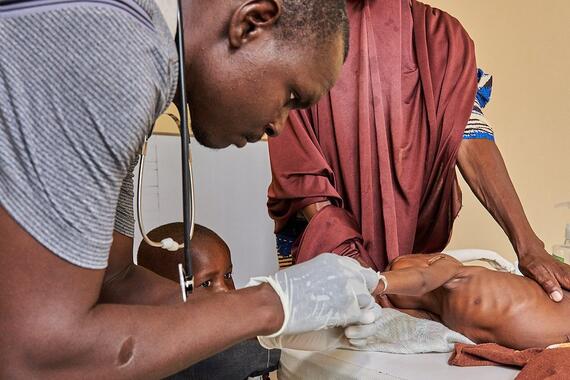
“I just want my child to get better”
Aisha Mohammed, 26, clasps her eight-month-old son, Ali, in her arms. Ali has sepsis – a serious infection stemming from a compromised immune system due to acute malnutrition. His small, frail body bears the tell-tale signs of poor nutrition.
"I just want my child to get better,” says Aisha. “Life has always been harsh and continues to be so. During the time when we were held captive [by a non-State armed group], our diet primarily consisted of guinea corn and various soups prepared with zobo [hibiscus] leaves. We have been unable to eat the way we used to."
Aisha is one of many people who arrived in Bama from inaccessible areas in Borno to find help.
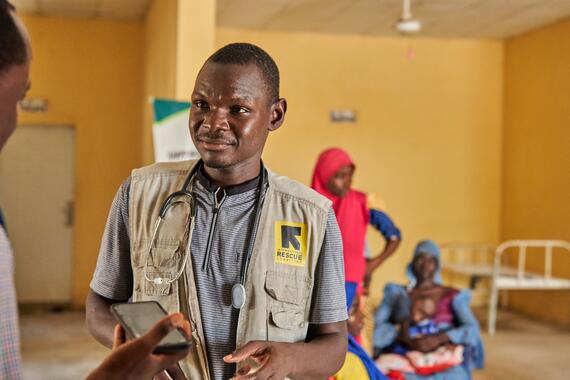
Dr. Meshach Mohzo, head of the stabilization centre, is concerned about the malnutrition situation.
"We are witnessing numerous cases of malnutrition in Gwoza,” he explains. “We receive approximately 5 to 10 emergency cases daily that require immediate treatment.”

Fatima Mohammed, 28, brought her twins, Hussaini and Hussain, to the stabilization centre, as they were showing signs of severe acute malnutrition.
The doctors’ timely care gave Fatima a glimmer of hope, but there was still fear in her eyes.
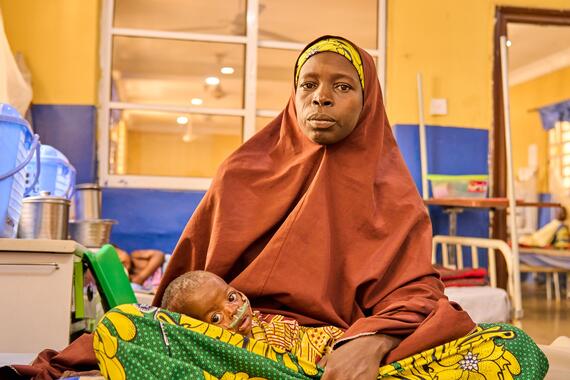
“Sometimes the stabilization centre is a home because you have enough to eat there”
Falmata Goni, 26, and her daughter, Aisha, live in the overcrowded Bama GSSS IDP Camp. Constructed to accommodate about 25,000 people, the camp now houses nearly 100,000 IDPs.
Falmata brought Aisha to Bama General Hospital's stabilization centre, which is managed by humanitarian partners. The doctor inserted a feeding tube to facilitate intensive treatment for Aisha.
"There was a scarcity of food in the [IDP] camp when we arrived. I was advised to bring Aisha to the stabilization centre immediately to prevent her from dying from this unknown illness,” said Falmata. “Sometimes the stabilization centre is a home because you have enough to eat there.”
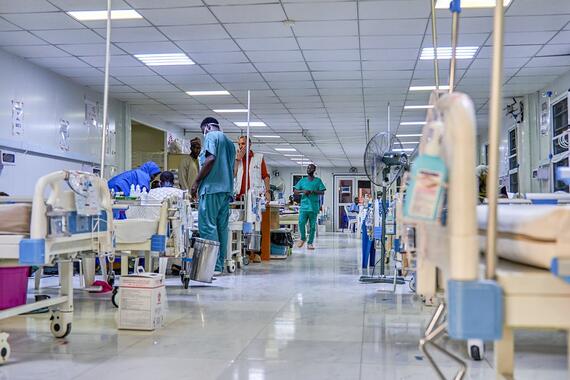
Late 2021 saw the closure of official IDP camps. Living conditions are extremely harsh for many people. Some face movement restrictions, preventing them from earning a living or growing crops.
There are places where people’s vulnerability has increased. In 2022 there was a huge increase in the number of patients treated by Médecins Sans Frontières (MSF) for severe malnutrition; more than 8,000 children were hospitalized for intensive nutrition care. And between January and May 2023, some 2,530 malnourished children were admitted for intensive care at the MSF stabilization centre. That’s an increase of about 120 per cent compared to the same period last year.
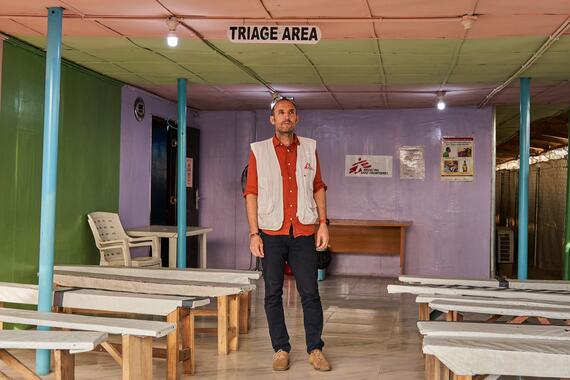
“Authorities and aid organizations need to immediately ramp up malnutrition-related activities and increase bed capacity in intensive therapeutic feeding centres,” said Gabriele Santi, MSF Project Coordinator in Maiduguri. “They also need to improve living conditions in transit camps and expand people’s access to health care.”
Since late April 2023, almost all of the stabilization centres in Maiduguri have been full, leaving many children waiting in line for an available bed.
The nutrition sector urgently needs approximately US$4 million to increase bed capacity (by about 220 beds), support the operational costs of stabilization centres and implement a harmonized nutrition response across Borno State during the lean season.
Additionally, $4 million is needed to ensure a secure pipeline of life-saving nutrition commodities.
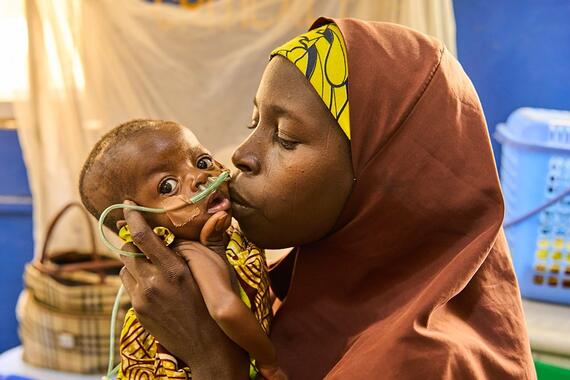
Responding to the lean season nutrition crisis
Efforts are urgently required to prevent a food and nutrition crisis in north-east Nigeria from turning catastrophic.
Some 4.3 million people in the BAY states face the risk of severe hunger at the peak of the lean season, from June to August. More than half a million of these people may face emergency levels of food insecurity, with extremely high rates of severe acute malnutrition that could result in death.
The lean season overlaps with the rainy season, raising concerns of disease outbreaks such as diarrhoea, cholera and malaria, which will further endanger the lives of already malnourished children.
Years of protracted conflict and insecurity continue to prevent many people from growing the food they need or earning an income to procure food. A naira cash crisis earlier in the year, fuel scarcity, increased food prices, inadequate food and health systems, and rising prices of agricultural inputs, such as fertilizers, have contributed to the crisis. And extreme weather shocks, such as last year’s climate-related floods, are making the situation much worse.
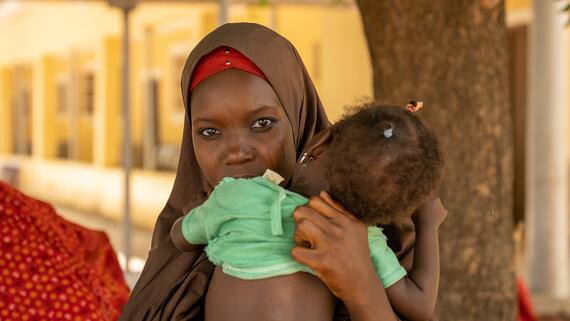
In response, partners have developed a lean season food security and nutrition multisector crisis plan, drawn from the 2023 Humanitarian Response Plan.
Humanitarian organizations urgently need $396.1 million to scale up food, nutrition, health, protection, and water, sanitation and hygiene support in the BAY states over the next six months.
For the food security response, at least $235 million is urgently needed to increase the number of people receiving food assistance, and to ramp up agricultural livelihood activities.
For the nutrition response, $65.8 million is urgently required.
The early disbursement of funds is critical to scale up preventive services and case management, including support to stabilization centres that are either non-functional or operating at suboptimal capacity due to a lack of funding. Partners also need funds to conduct nutrition surveys and mass mid-upper-arm circumference screening, especially in the hotspot LGAs, for timely updates on the evolving nutrition situation.
The multisector crisis plan is seeking $15.7 million for interventions in health, and $45 million for interventions in water, sanitation and hygiene.
The World Food Programme aims to provide 2.1 million people with emergency food and nutrition. The UN Children’s Fund and partners aim to provide nutritional services to more than 1 million malnourished children and pregnant or breastfeeding women. The Food and Agriculture Organization of the UN aims to assist 2 million people with seed packages for cereal production.
On 20 June, the UN allocated a combined $20 million — including $9 million from the Central Emergency Response Fund (CERF) and a complementary $11 million from the Nigeria Humanitarian Fund (NHF) — to urgently ramp up the humanitarian response to the worsening food security and nutrition crisis in north-east Nigeria.
To support Government efforts, the CERF and NHF funding will go towards a coordinated multisectoral response, including ready-to-eat therapeutic food, access to clean water, health care and agriculture support, to help prevent famine or famine-like conditions. The emergency funding is welcome, but it represents about 5 per cent of the $396 million requirement.
Delayed funding will have devastating consequences for millions of children.
Text: Adedeji Ademigbuji & Ann Weru - Photos: Adedeji Ademigbuji - Edited by: Nina Doyle
